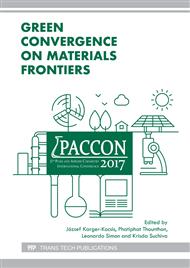[1]
A. Umar, J.A. K Khairil, A. Nor, A review of the properties and applications of Poly (Methyl Methacrylate) (PMMA), Polymer Reviews, 0 (2015) 1-28.
Google Scholar
[2]
M. Sangermano, W. D. Cook, S. Papagna, S. Grassini, Hybrid UV-cured organic–inorganic IPNs, European Polymer Journal, 48 (2012), 1796-1804.
DOI: 10.1016/j.eurpolymj.2012.07.002
Google Scholar
[3]
J-R. Cha, M-S. Gong, Preparation of epoxy/polyelectrolyte IPNs for flexible polyimide-based humidity sensors and their properties, Sensors and Actuators B, 178 (2013) 656- 662.
DOI: 10.1016/j.snb.2013.01.021
Google Scholar
[4]
J. Sethi b, M. Illikainen, M. Sain, K. Oksman, Polylactic acid/polyurethane blend reinforced with cellulose nanocrystals with semi-interpenetrating polymer network (S-IPN) structure, European Polymer Journal, 86 (2017), 188-199.
DOI: 10.1016/j.eurpolymj.2016.11.031
Google Scholar
[5]
M.S. Um, D.S. Ham, S. K. Cho, S-J Lee, K.J. Kim, J. H. Lee, S-H Choa, H.W. Jung, W.J. Choi, Surface mechanical properties of poly (urethane acrylate)/silica hybrid interpenetrating polymer network (IPN) coatings, Progress in Organic Coatings, 97 (2016).
DOI: 10.1016/j.porgcoat.2016.04.007
Google Scholar
[6]
C. Sriprachuabwong, N. Kreua-ongarjnukool, K. Charmondusit, Effect of impact modifiers and laminator on the damage properties of transparent acrylic cast sheet, The 2nd Technology and Innovation for Sustainable Development Conference, Khon Kaen, Thailand (2008).
Google Scholar
[7]
P.S.O. Patrício, J.A. de Sales, G.G. Silva, D. Windmöller, J.C. Machado, Effect of blend composition on microstructure, morphology, and gas permeability in PU/PMMA blends, Journal of Membrane Science, 271 (2006), 177-185.
DOI: 10.1016/j.memsci.2005.06.064
Google Scholar
[8]
J. Sethi, M. Illikainen, M. Sain, K. Oksman, Polylactic acid/polyurethane blend reinforced with cellulose nanocrystals with semi-interpenetrating polymer network (S-IPN) structure, European Polymer Journal, 86 (2017), 188-199.
DOI: 10.1016/j.eurpolymj.2016.11.031
Google Scholar
[9]
E. Amerio, P. Fabbri, G. Malucelli, M. Messori, M. Sangermano, R. Taurino, Scratch resistance of nano-silica reinforced acrylic coatings, Journal of Progress in Organic Coatings, 62 (2008), 129 -133.
DOI: 10.1016/j.porgcoat.2007.10.003
Google Scholar
[10]
K. K. Jena and K.V.S.N. Raju, Synthesis and characterization of hyperbranched polyurethane hybrids using tetraethoxysilane (TEOS) as Cross-Linker, Industrial and Engineering Chemistry Research, 47 (2008), 9214-9224.
DOI: 10.1021/ie800884y
Google Scholar
[11]
A.R. Mahdavian, M. Ashjari, A.B. Makoo, Preparation of poly (styrene–methyl methacrylate) /SiO2 composite nanoparticles, European Polymer Journal, 43 (2007), 336-344.
DOI: 10.1016/j.eurpolymj.2006.10.004
Google Scholar
[12]
I. Intharit, C. Klinmala, K. Klaharn, A. Sanprasert, N. Kreua-ongarjnukool, Improved Impact modification of poly (methyl methacrylate) sheet with impact modifier by using interpenetrating polymer networks (IPNs) in casting process. Youth Climate Conference Asia International Workshop, Milset Asia, State of Kuwait, 16-20 February, (2009).
Google Scholar
[13]
K. J. Kishore and K. V. S. N. Raju, Synthesis and characterization of hyperbranched polyurethane hybrids using tetraethoxysilane (TEOS) as cross-linker, Industrial & Engineering Chemistry Research, 47 (23) (2008), 9214-9224.
DOI: 10.1021/ie800884y
Google Scholar
[14]
K. K. Jena and K. V. S. N. Raju, Synthesis and characterization of hyperbranched polyurethane hybrids using tetraethoxysilane (TEOS) as cross-linker, Ind. Eng. Chem. Res, 47 (2008), 9214-9224.
DOI: 10.1021/ie800884y
Google Scholar
[15]
C.A. Ou and M.C. Hsu, Preparation and properties of cycloolefin copolymer/silica hybrids, Journal of Applied Polymer Science, 104 (2007), 2542-2548.
DOI: 10.1002/app.25983
Google Scholar
[16]
T. CË aykara, O. GuÈven, UV degradation of poly (methyl methacrylate) and its vinyltriethoxy- silane containing copolymers, Polymer Degradation and Stability, 65 (1999) 225-229.
DOI: 10.1016/s0141-3910(99)00008-7
Google Scholar


